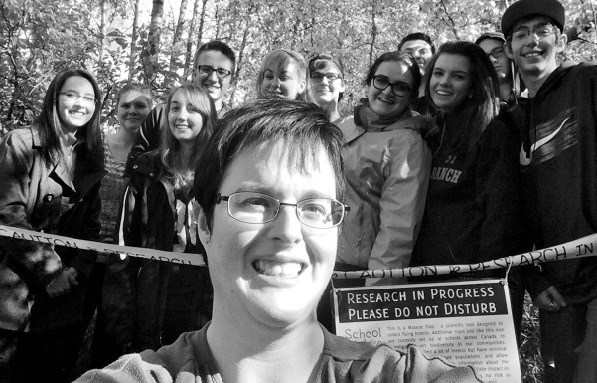The Preeceville School Biology 30 class has been learning about scientific classification of living beings in Biology 30 so that they can classify some of the insects in and around the Preeceville area through a School Malaise Trap Program.
“Preeceville, located in east central Saskatchewan, is very fortunate to be in an area that is very biologically diverse,” said Heidi Paterson, teacher. “Our town is in a parkland transition between the boreal forest and the prairie. Our nearby lakes are “pit stops” for many migratory bird species. We deployed our Malaise trap on the southern shore of Annie Laurie Lake near the bird trails and beach on September 21.This is about a 10minute walk from our school. On September 18th, we ventured up to Annie Laurie Lake and we found a perfect spot to set up our malaise trap (minus the collection bottle). We also spent some time in our Biology 30 class developing some questions for this field experiment,” she said.
The things the students are learning in this class includes: what species of Class Insecta are present in Preeceville (Annie Laurie Lake): What is the representation of species (i.e. order, family) found in Preeceville (Annie Laurie Lake)/ Are there species indigenous to our area and can they be found at other collections sites, and what information will DNA decoding reveal about genetic relationships among the species found in our area.
On Monday morning, Heidi Paterson placed the collection bottle on the Malaise Trap and will check it through the week.
The malaise trap is a tent-like device that is effective in being used in collecting scientific research. The trap is generally placed in a natural flyway where it can collect hundreds of flying insects over time, thereby providing a very detailed understanding of local biodiversity. The collected data can be used to monitor programs that seek to track both long term trends as well as to evaluate the impacts of human activities on species diversity. The collection bottle from the trap is brought back from the field and each specimen is processed and bar coded at the Canadian Centre for DNA barcoding. This DNA barcode and other information about the specimen is added to the Bar Code of Life Data System. DNA barcodes are unique genetic signatures. Earth is home to many millions of species but 250 years of traditional study has described fewer that two million of them, she said.




